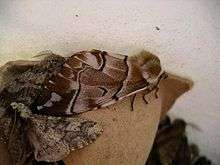Endromis versicolora
| Kentish glory Endromis versicolora | |
|---|---|
 | |
| Scientific classification | |
| Kingdom: | Animalia |
| Phylum: | Arthropoda |
| Class: | Insecta |
| Order: | Lepidoptera |
| Family: | Endromidae |
| Genus: | Endromis Ochsenheimer, 1810 |
| Species: | E. versicolora |
| Binomial name | |
| Endromis versicolora (Linnaeus, 1758) | |
| Synonyms | |
| |
Endromis versicolora, the Kentish glory, is a moth of the family Endromidae. It is found in the Palaearctic region.

The wingspan is 50–70 mm. The adults fly from March to May. Females, are much larger and paler than the males, and fly only at night in order to lay eggs. Males, which fly both by night and day, can detect female pheromones from a distance up to 2 km.
Yellow at first, then purplish-brown eggs are laid in 2–3 "rows" around thin branch of birch. After 10–14 days little black caterpillars hatch.
The caterpillars primarily feed on birch (Betula sp.), but accepts lots of other trees and shrubs: Alnus sp., Corylus sp., Tilia sp., Carpinus sp. It is green with paler stripes, at first feeds in small groups of 15–30 larvae. Mature ones separate and feed only at night individually.
Endromis versicolora has a single generation a year; it overwinters as a chrysalis in thin, loose, but strong cocoon buried in the soil at a shallow depth.
External links
| Wikimedia Commons has media related to Endromis versicolora. |
_Dos.jpg)
_ventre.jpg)
_Dos.jpg)
_Ventre.jpg)